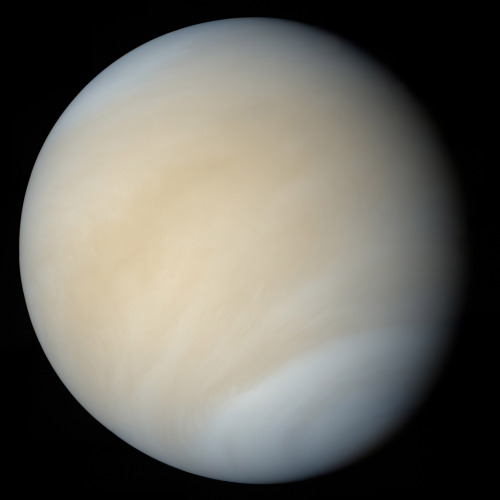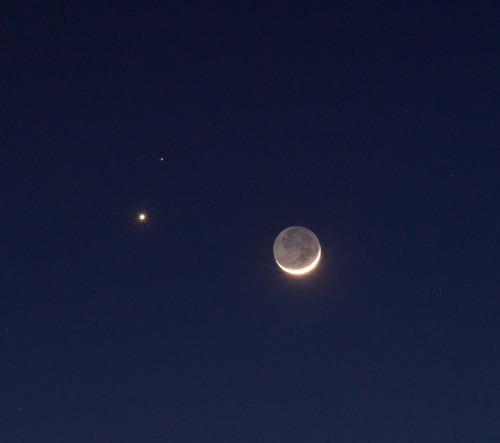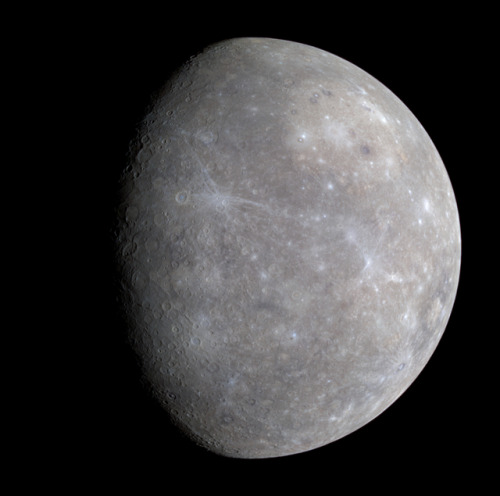Stephen Hawking: A Brief History Of Genius
Stephen Hawking: a brief history of genius
London (AFP) March 14, 2018 Stephen Hawking, who has died aged 76, was Britain’s most famous modern day scientist, a genius who dedicated his life to unlocking the secrets of the Universe. Born on January 8, 1942 - 300 years to the day after the death of the father of modern science, Galileo Galilei - he believed science was his destiny. But fate also dealt Hawking a cruel hand. Most of his life was spent in Full article
More Posts from Venusearthpassage and Others









Comparison of the planets of the solar system, Pluto and Sun in relation to the earth.
Images: commons.wikimedia (Sun: Alan Friedman)










Solar System Infographs




Venus as seen from the Mariner 10 probe taken in 1974
Ten Interesting facts about Venus
As one of the brightest objects in the sky, Venus has been a major fixture in human culture for as long as records have existed. It has been made sacred to gods of many cultures, and has been a prime inspiration for writers and poets as the “morning star” and “evening star”. Venus was the first planet to have its motions plotted across the sky, as early as the second millennium BC.

Venus is the second planet from the Sun, orbiting it every 224.7 Earth days. It has the longest rotation period (243 days) of any planet in the Solar System and rotates in the opposite direction to most other planets.

It does not have any natural satellites. It is named after the Roman goddess of love and beauty.

It is the second-brightest natural object in the night sky after the Moon, reaching an apparent magnitude of −4.6 – bright enough to cast shadows at night and, rarely, visible to the naked eye in broad daylight.

Venus is a terrestrial planet and is sometimes called Earth’s “sister planet” because of their similar size, mass, proximity to the Sun, and bulk composition.

It is radically different from Earth in other respects. It has the densest atmosphere of the four terrestrial planets, consisting of more than 96% carbon dioxide. The atmospheric pressure at the planet’s surface is 92 times that of Earth, or roughly the pressure found 900 m (3,000 ft) underwater on Earth. Venus is by far the hottest planet in the Solar System, with a mean surface temperature of 735 K (462 °C; 863 °F), even though Mercury is closer to the Sun.

As the closest planet to Earth, Venus has been a prime target for early interplanetary exploration. It was the first planet beyond Earth visited by a spacecraft (Mariner 2 in 1962), and the first to be successfully landed on (by Venera 7 in 1970). Venus’s thick clouds render observation of its surface impossible in visible light, and the first detailed maps did not emerge until the arrival of the Magellan orbiter in 1991. Plans have been proposed for rovers or more complex missions, but they are hindered by Venus’s hostile surface conditions.

Much of the Venusian surface appears to have been shaped by volcanic activity. Venus has several times as many volcanoes as Earth, and it has 167 large volcanoes that are over 100 km (62 mi) across. The only volcanic complex of this size on Earth is the Big Island of Hawaii. This is not because Venus is more volcanically active than Earth, but because its crust is older. Earth’s oceanic crust is continually recycled by subduction at the boundaries of tectonic plates, and has an average age of about 100 million years, whereas the Venusian surface is estimated to be 300–600 million years old.

As it orbits the Sun, Venus displays phases like those of the Moon in a telescopic view. The planet appears as a small and “full” disc when it is on the opposite side of the Sun (at superior conjunction). Venus shows a larger disc and “quarter phase” at its maximum elongations from the Sun, and appears its brightest in the night sky. The planet presents a much larger thin “crescent” in telescopic views as it passes along the near side between Earth and the Sun. Venus displays its largest size and “new phase” when it is between Earth and the Sun (at inferior conjunction). Its atmosphere is visible through telescopes by the halo of sunlight refracted around it.

The Venusian orbit is slightly inclined relative to Earth’s orbit; thus, when the planet passes between Earth and the Sun, it usually does not cross the face of the Sun. Transits of Venus occur when the planet’s inferior conjunction coincides with its presence in the plane of Earth’s orbit. Transits of Venus occur in cycles of 243 years with the current pattern of transits being pairs of transits separated by eight years, at intervals of about 105.5 years or 121.5 years—a pattern first discovered in 1639 by the English astronomer Jeremiah Horrocks.

In 1967, Venera 4 found Venus’s magnetic field to be much weaker than that of Earth. This magnetic field is induced by an interaction between the ionosphere and the solar wind, rather than by an internal dynamo as in the Earth’s core. Venus’s small induced magnetosphere provides negligible protection to the atmosphere against cosmic radiation.
source
images: Mattias Malmer/NASA/JPL, Peter Barvoets, Soviet Planetary Exploration Program, NSSDC, Marc Lecleire, ESA, C. Carreau,
Die Perkins-Stimmen wieder vereint ...

Die Startfolge der Hörspielserie Mark Brandis, Raumkadett überrascht die Commander-Perkins-Fans mit einer Wiedervereinigung der Stimmen ihrer Helden: Nach 34 Jahren sind Horst Stark, Gabi Libbach und Gernot Endemann erstmals wieder zusammen in einem Science-Fiction-Werk zu hören …
Alle Links in unserer “Ortungsleitzentrale” (olz)…

Computer Simulated Global View of Venus.
📷 NASA/Jet Propulsion Laboratory-Caltech

On this day, but in 1974 the NASA spacecraft Mariner 10 made its closest approach to Venus.
Credit: NASA / Mariner 10
Ten Interesting facts about Mercury
Mercury is the closest planet to the sun. As such, it circles the sun faster than all the other planets, which is why Romans named it after their swift-footed messenger god. He is the god of financial gain, commerce, eloquence, messages, communication (including divination), travelers, boundaries, luck, trickery and thieves; he also serves as the guide of souls to the underworld

Like Venus, Mercury orbits the Sun within Earth’s orbit as an inferior planet, and never exceeds 28° away from the Sun. When viewed from Earth, this proximity to the Sun means the planet can only be seen near the western or eastern horizon during the early evening or early morning. At this time it may appear as a bright star-like object, but is often far more difficult to observe than Venus. The planet telescopically displays the complete range of phases, similar to Venus and the Moon, as it moves in its inner orbit relative to Earth, which reoccurs over the so-called synodic period approximately every 116 days.

Mercury’s axis has the smallest tilt of any of the Solar System’s planets (about 1⁄30 degree). Its orbital eccentricity is the largest of all known planets in the Solar System; at perihelion, Mercury’s distance from the Sun is only about two-thirds (or 66%) of its distance at aphelion.

Its orbital period around the Sun of 87.97 days is the shortest of all the planets in the Solar System. A sidereal day (the period of rotation) lasts about 58.7 Earth days.

Mercury’s surface appears heavily cratered and is similar in appearance to the Moon’s, indicating that it has been geologically inactive for billions of years. Having almost no atmosphere to retain heat, it has surface temperatures that vary diurnally more than on any other planet in the Solar System, ranging from 100 K (−173 °C; −280 °F) at night to 700 K (427 °C; 800 °F) during the day across the equatorial regions. The polar regions are constantly below 180 K (−93 °C; −136 °F). The planet has no known natural satellites.

Unlike many other planets which “self-heal” through natural geological processes, the surface of Mercury is covered in craters. These are caused by numerous encounters with asteroids and comets. Most Mercurian craters are named after famous writers and artists. Any crater larger than 250 kilometres in diameter is referred to as a Basin.

The largest known crater is Caloris Basin, with a diameter of 1,550 km. The impact that created the Caloris Basin was so powerful that it caused lava eruptions and left a concentric ring over 2 km tall surrounding the impact crater.

Two spacecraft have visited Mercury: Mariner 10 flew by in 1974 and 1975; and MESSENGER, launched in 2004, orbited Mercury over 4,000 times in four years before exhausting its fuel and crashing into the planet’s surface on April 30, 2015.

It is the smallest planet in the Solar System, with an equatorial radius of 2,439.7 kilometres (1,516.0 mi). Mercury is also smaller—albeit more massive—than the largestnatural satellites in the Solar System, Ganymede and Titan.

As if Mercury isn’t small enough, it not only shrank in its past but is continuing to shrink today. The tiny planet is made up of a single continental plate over a cooling iron core. As the core cools, it solidifies, reducing the planet’s volume and causing it to shrink. The process crumpled the surface, creating lobe-shaped scarps or cliffs, some hundreds of miles long and soaring up to a mile high, as well as Mercury’s “Great Valley,” which at about 620 miles long, 250 miles wide and 2 miles deep (1,000 by 400 by 3.2 km) is larger than Arizona’s famous Grand Canyon and deeper than the Great Rift Valley in East Africa.

The first telescopic observations of Mercury were made by Galileo in the early 17th century. Although he observed phases when he looked at Venus, his telescope was not powerful enough to see the phases of Mercury.
source 1
source 2
source 3
images: Joseph Brimacombe, NASA/JPL, Wikimedia Commons


Transit of Venus in 2012
Credit: NASA / SDO
-
 ihlni686-and-rps liked this · 7 years ago
ihlni686-and-rps liked this · 7 years ago -
 brown-eyed-thang liked this · 7 years ago
brown-eyed-thang liked this · 7 years ago -
 thatoneguy4217 liked this · 7 years ago
thatoneguy4217 liked this · 7 years ago -
 sophii-uh-blog reblogged this · 7 years ago
sophii-uh-blog reblogged this · 7 years ago -
 venusearthpassage reblogged this · 7 years ago
venusearthpassage reblogged this · 7 years ago -
 nikitaboeve liked this · 7 years ago
nikitaboeve liked this · 7 years ago -
 wandererwithmakoeyes reblogged this · 7 years ago
wandererwithmakoeyes reblogged this · 7 years ago -
 wandererwithmakoeyes liked this · 7 years ago
wandererwithmakoeyes liked this · 7 years ago -
 fyreball66 reblogged this · 7 years ago
fyreball66 reblogged this · 7 years ago -
 fyreball66 liked this · 7 years ago
fyreball66 liked this · 7 years ago -
 earthreality liked this · 7 years ago
earthreality liked this · 7 years ago -
 pipius reblogged this · 7 years ago
pipius reblogged this · 7 years ago -
 pipius liked this · 7 years ago
pipius liked this · 7 years ago -
 spacetimewithstuartgary reblogged this · 7 years ago
spacetimewithstuartgary reblogged this · 7 years ago -
 wchouffotartist liked this · 7 years ago
wchouffotartist liked this · 7 years ago -
 donnnoh liked this · 7 years ago
donnnoh liked this · 7 years ago -
 vivichan89 liked this · 7 years ago
vivichan89 liked this · 7 years ago -
 semajzayd reblogged this · 7 years ago
semajzayd reblogged this · 7 years ago -
 semajzayd liked this · 7 years ago
semajzayd liked this · 7 years ago -
 nuclearparadox liked this · 7 years ago
nuclearparadox liked this · 7 years ago -
 a-golden-bear liked this · 7 years ago
a-golden-bear liked this · 7 years ago -
 catshapeddarkness liked this · 7 years ago
catshapeddarkness liked this · 7 years ago -
 nanonym27 liked this · 7 years ago
nanonym27 liked this · 7 years ago -
 echo1331 liked this · 7 years ago
echo1331 liked this · 7 years ago -
 clubsodababy liked this · 7 years ago
clubsodababy liked this · 7 years ago -
 tardis-in-a-moonbeam liked this · 7 years ago
tardis-in-a-moonbeam liked this · 7 years ago -
 thebusylilbee reblogged this · 7 years ago
thebusylilbee reblogged this · 7 years ago -
 authoritative-benevolence liked this · 7 years ago
authoritative-benevolence liked this · 7 years ago -
 whatsabobtoanoutkast liked this · 7 years ago
whatsabobtoanoutkast liked this · 7 years ago -
 spaceexp reblogged this · 7 years ago
spaceexp reblogged this · 7 years ago